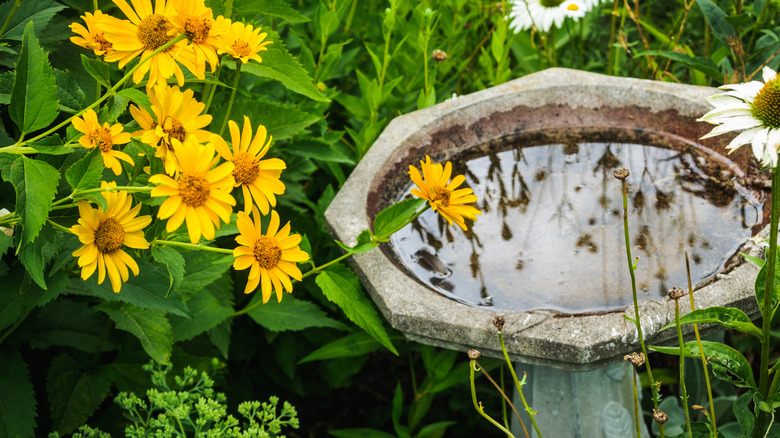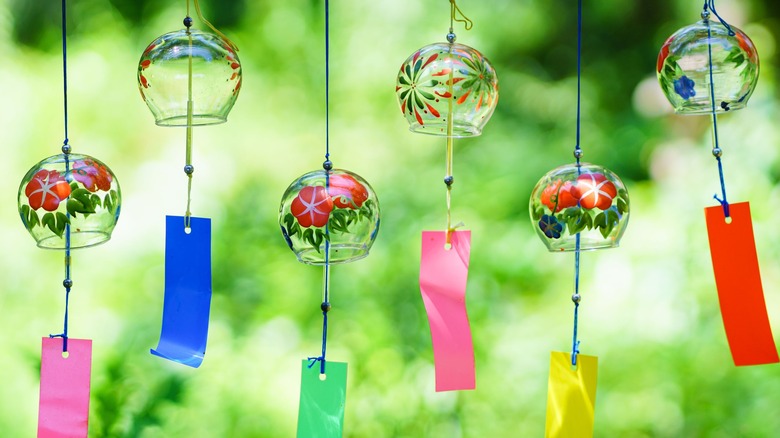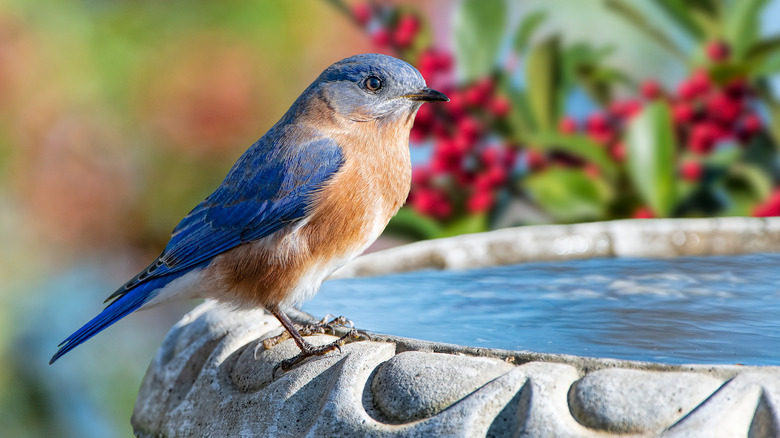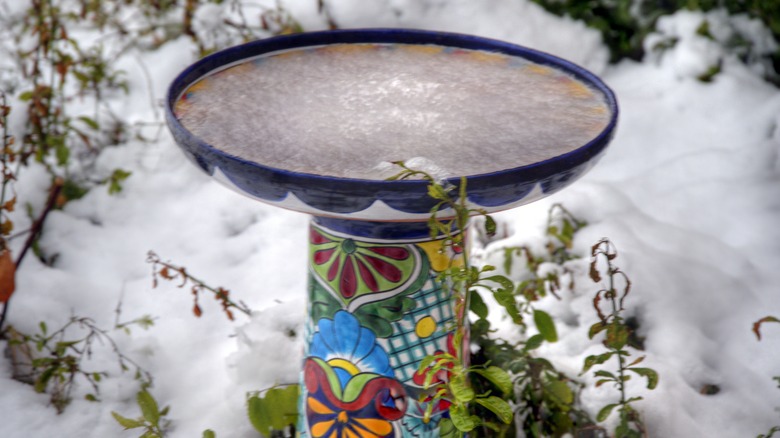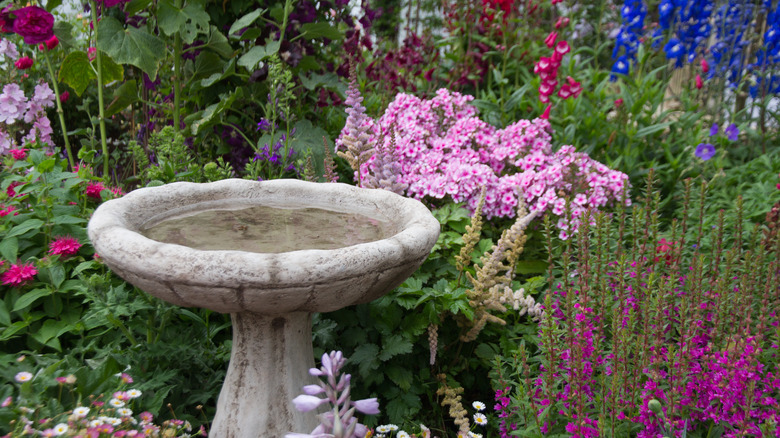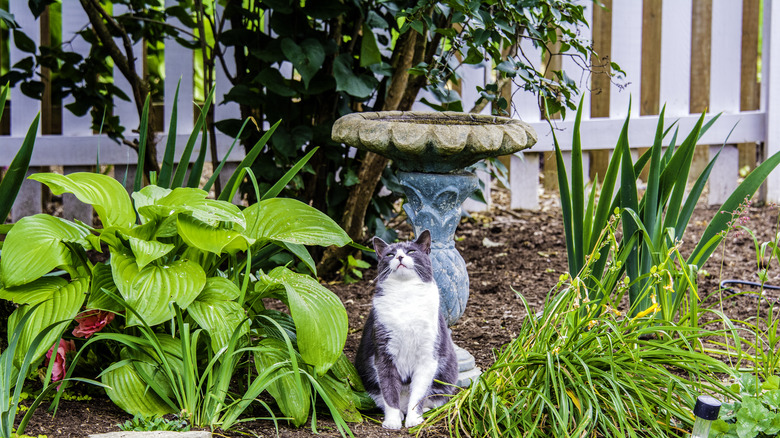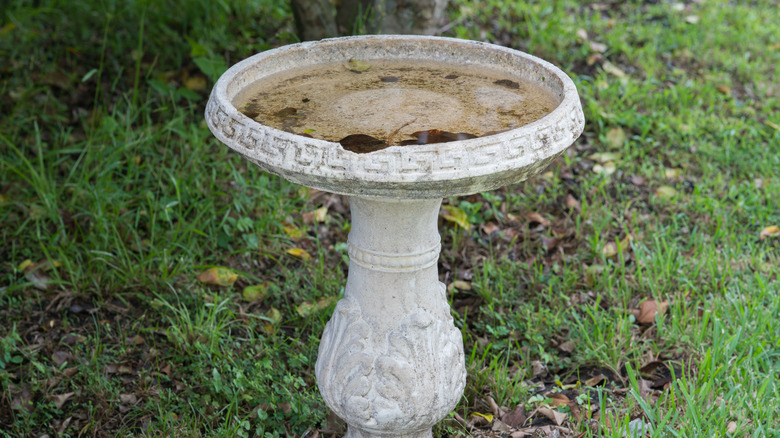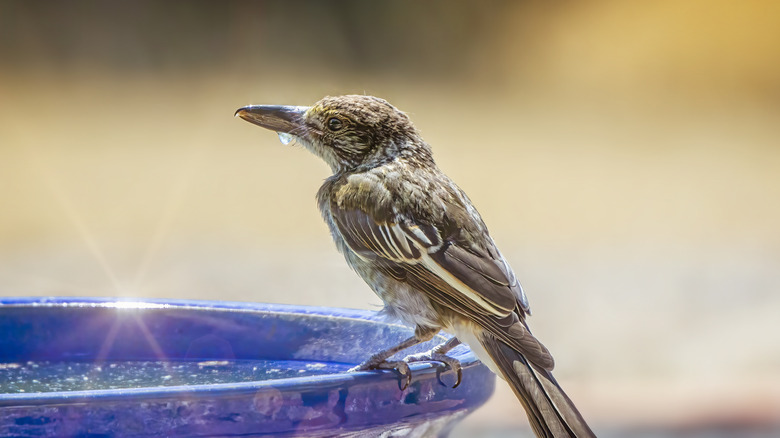This Is Why Birds Want Nothing To Do With Your Birdbath
A bird in the bush looks great! A bird perched on a tree looks divine. Yet a bird frolicking in the water is the sweetest sight of all – which is why birdbaths in the yard are so popular. Watching our little feathered friends having a cheeky dip on a summer's day or a refreshing guzzle on a winter's morning is one of life's simple pleasures. Birdbaths are relatively inexpensive and easy to set up, but unfortunately, they are sometimes ignored by everything with a pair of wings and a beak.
If you've gone the extra yard to make your birdbath look as pretty and inviting as possible, but it remains about as attractive to the local avian population as a small steel cage, fear not! The birds are not visiting your birdbath for a number of reasons and all of them are fixable. It could be simply located in the wrong position, a little too deep or slippery, or too accessible to potential predators. Either way, there's a remedy to the situation. Read on to find out how you can make your birdbath the most popular watering hole in the neighborhood for frequent fliers.
Your yard isn't welcoming to birds
The problem might not be your birdbath, but your yard. If you have pets, a curious cat, or an enthusiastic dog it can be quite a deterrent. Birds will also give noisy children at play a wide berth as they regard them as potential predators. Stone statues may look aesthetically pleasing but they can spook them. Loud music, noisy air conditioning units, and wind chimes can also make our feathered friends want to keep their distance, as can bright garden decorations such as pinwheels and flags. Additionally, if you use insecticides or herbicides in your yard it could be killing off the insects and seed-heavy flowers birds rely on for their food source.
We all want our yards to look as aesthetically pleasing as possible. We also want them filled with the scents of flowers and birdsong. So think twice before you prune those branches that could be a potential perch for a visiting bird. Keeping the area as natural as possible is key to attracting birds to your garden. Planting an array of flowers will add color and nectar to your yard, and an abundance of shrubs will also provide them with cover and protection. Try isolating an area of your yard for your pets and children whilst creating a haven for birds. This area will be the perfect place for a birdbath. Children are never too young to learn about the value of respecting wildlife and will learn a lot from watching them bathe. Keep noise to a minimum, remove any decor that is not bird-friendly, stop with the chemical products, and your birdbath will soon become a prime piece of real estate in the avian world.
It's deep enough to drown
No one likes to feel out of their depth and this includes birds. If you're providing them with an Olympic-sized pool when all they want is a puddle to wet their beak and dip their claws, then your birdbath is not going to lure them in. In the worst-case scenario, young, wounded, or ill birds can drown in a birdbath that is too deep. Our feathered friends prefer shallow birdbaths because they are not particularly fond of swimming. Additionally, they lack the webbed feet of ducks, geese, and swans, and need to stand up in the water
Ideally, the water in your birdbath should be somewhere between 1-3 inches so that both little and large birds can bathe safely. If your bird bath is naturally too deep, placing rocks in the pool for the birds to perch on and making the water levels safe usually works. Always use rocks that are not too smooth so the birds can get a good grip when standing upon them. Also, ensure that they are evenly spaced and that there are no large gaps between them that little birds could accidentally fall into. If you prefer you could use sticks as a substitute for rocks, or you could get creative and use a combination of both.
The water is freezing
Although many people tend to sing about the benefits of ice baths until they are blue in the face, birds do not particularly enjoy taking a dip in sub-zero conditions. Yet, like all critters, they need to drink. And during the winter months, it's important to ensure your birdbath has a ready supply of drinking water when the temperatures plummet. The key is not to let the water freeze and become unsuitable for drinking. Don't make the mistake of thinking that most birds fly south. Plenty stick around, and they rely on all available water sources. However, if your water sits frozen, your birdbath will also stand unpopulated.
If it is to survive freezing conditions it's best to opt for a birdbath made of plastic or resin as opposed to one made from the more traditional materials of stone, cement, or glass. These are less frost-resistant and more at risk of cracking. Darker-colored birdbaths will be better at absorbing heat and keeping the water warmer for longer. Ensure you place it in a location in your yard that will maximize all available sunlight and has a natural or artificial windbreak. Adding black rocks to the birdbath or covering the bottom of the bowl with black plastic will help it hold onto the sun's warmth longer. If you add a ping-pong ball to the birdbath it will hang about on the water's surface and help prevent it from icing over. If your birdbath does freeze over never add salt or chemicals to defrost it as this can make the birds sick. It's tempting to add boiling water but this can shatter the bowl. Your best bet is to place a pan of boiling water directly on the ice and wait for it to melt. Or, for extra peace of mind, consider looking into adding a heated birdbath.
It doesn't have a staging or preening perch
There's nothing like relaxing on a lounger after a soak in the pool on a hot summer's day to contemplate life's mysteries and maybe top up on the sunscreen. Birds are no different! After bathing, they like to have somewhere to chill near the water to shake, indulge in a little preening, and check their plumage. Additionally, birds don't like swooping straight from the skies and into the water. They prefer the more civilized landing that a perching platform affords them. A perch will instantly make your birdbath a lot more attractive to our feathered friends, and give them time to check out the locale before taking the plunge.
If your birdbath doesn't have a staging or preening perch, it's an easy fix. Simply move it to an area of your yard where there are some handy tree branches or shrubs nearby. If you have none, you can create an artificial perch. Simply collect some fallen branches or driftwood, the more gnarled and covered in moss the better. The next step is to attach them to an existing post, bird feeder pole or purpose-made perch supports available from most home and garden stores. The perches don't need to be heavy and can be attached via cable ties, wire, twine, or bungee cords. Once the perch is primed, you should notice a big difference in the volume of traffic to your birdbath.
It's within easy reach of predators
Moving your birdbath to an area of your yard where there's plenty of foliage and overhanging branches isn't just a handy means of providing your winged visitors with a perch. It also provides them with invaluable protection from predators when they're concentrating a large part of their energies and focus on bathing. Birds are, by nature, very skittish and timid creatures. If your birdbath is surrounded by wide open spaces, they're potential sitting ducks for any bloodthirsty cats or hawks who happen to be on the prowl. If the birds feel the bath you're offering isn't enough of a secure space, they'll take to the wing and try somewhere else. Putting it in the middle of the garden where it can be attacked on all sides is a definite no-go. This gives them no privacy or protection and they'll avoid it like the plague.
You need to place the birdbath in an area that is visible to you and allows the birds a good view of their surroundings. However, you also need to make the birds feel protected. You can do this by putting one side of the bath near a shed, tree, or even a house. However, don't place it too close. The goal is to provide the birds with an escape route when they feel threatened. If predators are given the opportunity to hide and wait before pouncing from nearby bushes, it defeats the purpose of providing the birds with protection in the first place.
The water is too still and stagnant
It's a simple fact of life! Water that glistens and sparkles is inviting, but water that is stagnant and dull is a warning not to approach under any circumstance. If the water in your birdbath is dirty don't be surprised when they don't come calling. Birds don't want to bathe in foul and filthy water and they don't want to drink it. They are aware that it could be contaminated and don't want to put their lives at risk.
It's recommended that the water in a birdbath is replaced every 2-4 days. However, if it looks dirty or grimy, is overflowing with debris, or emitting a bad smell, then you need to take direct action and thoroughly clean your birdbath. It's well known that water movement has a habit of catching a bird's eye. So you may want to add a water feature or a DIY bubbler to your existing birdbath to help entice them in. Adding some sort of fountain can work wonders, but you can also connect a mister or dripper to a hose and use that instead. An electric water pump placed in the birdbath is a great method of creating movement in the water but ensure you comply with the appropriate safety regulations to avoid electrocution and fires.
The surface is too slippery
Everything tends to get a little slippery when wet, but some surfaces are more prone to the problem than others, and if our feathered friends can't get a decent grip when they're bathing, they'll pass your birdbath on by. Anyone who's ever taken a slip in the shower or fallen in the bath will know the indignity and annoyance it entails, and it's no different for birds. Margaret C. Brittingham, former professor of wildlife resources at Pennsylvania State University told Homes & Gardens, "Birds do not like slippery surfaces, and baths made out of materials such as glazed pottery or smooth plastics are not as attractive as those with a rough surface like concrete or terracotta. "
If your birdbath already has a slippery surface, you can simply place pebbles or stones in the bottom to make things a lot easier for the birds. A lot of smaller birds have feet that are designed to grip objects as opposed to standing on a flat surface. Adding a few things for them to latch onto when bathing or drinking will make their life a lot easier and you should see a lot more visitors to your yard.
